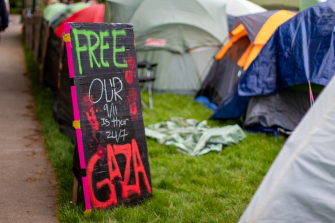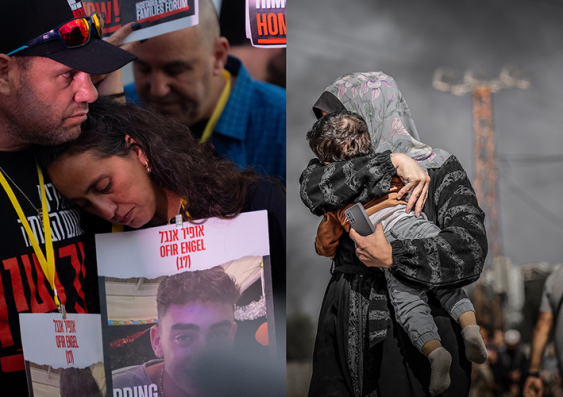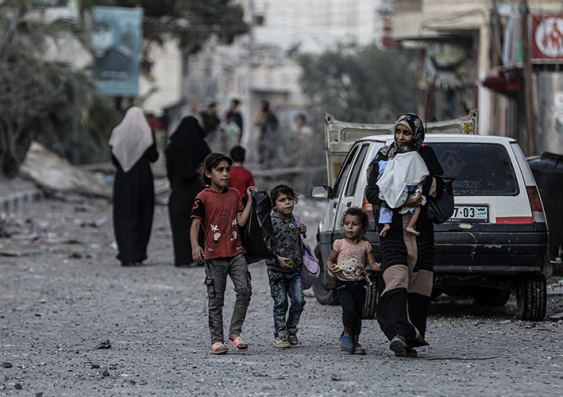Gaza sit-in reactions show limits of right to protest
27 May 2024

Aren't university campuses exactly the places where young adults should be allowed the maximum possible space to develop and share their political voices?
Photo: David Geitgey Sierralupe / Flickr
Pressure to close down the pro-Palestine encampments reminds us again that the limits of the right to protest are contested.
Pressure to close down the pro-Palestine encampments reminds us again that the limits of the right to protest are contested.
The emergence of Palestinian solidarity encampments on Australian university campuses in recent weeks has enlivened a perennial question: how healthy is the right to protest in Australia?
The question is usually framed in terms of the strength of the right rather than its very existence. And that is fair enough.
As a self-identifying liberal democracy, part of Australia's image is as a place that embraces freedom of expression and a commitment to political participation. After all, we are a party to the International Covenant on Civil and Political Rights, which includes the right of peaceful assembly (Article 21).
And while Australia lacks a national Bill of Rights, we do enjoy an "implied" freedom of political expression under the Constitution, and some states/territories (the ACT, Victoria and Queensland) expressly recognise the right to peaceful assembly and association.
That should mean something, right?
But while it is routine to embrace the idea of a right to protest in the abstract, realisation of that right has often been controversial.
For example, over the course of the last decade, lawmakers across Australia have enacted (or threatened to enact) a range of new legal measures that chip away at the right to protest.
Curiously, every time this happens, politicians making the case for change open their public remarks with a statement like, "This government is committed to the right to protest, but …"
What typically follows is an explanation of the proposed new offence (or increased penalty, or expanded police power) that is predicated on characterising the targeted form of protest as illegitimate, something that falls outside the protection of the law.
Pressure to close down the encampments that have been established to express support for the Palestinian people, and to protest the war being conducted in Gaza by the state of Israel, reminds us again that there are different views about the limits of what people are entitled to do in terms of public assembly and protest.
Most tensions and disagreements relate to one or more of the following: the location of the protest, the messages being communicated by the protesters, and the methods they are using.
To take another ongoing example, climate change action protesters tend not to be criticised so much for what they are saying, there being such wide consensus that there is a climate emergency.
What attracts ire (and triggers new and "improved" anti-protest laws) are the lengths protesters go to get their point across — such as blockading ports or hanging off bridges (and interrupting commerce and/or causing traffic disruptions).
University pro-Palestinian encampments in Australia seem to be controversial for different reasons. For the most part, these gatherings (which are a form of ‘standing' public assembly) are not designed to disrupt surrounding activities, in the way, say, that environmental protesters who ‘lock on' to mining or tree-felling equipment are very deliberately attempting to stop natural resource extraction activities.
The aim of the encampments is not to stop teaching and research activities, but to draw attention to the plight of the people of Gaza and Palestine, condemn Israel's actions in Gaza, demand a permanent ceasefire, and make high-visibility demands of university leaders (including ending any research or commercial ties with the Israeli Defense Forces).
The main objections mounted against them is that, by their presence, by their messages and by their chants, they are creating a situation in which some Jewish students feel unsafe.
This is no small matter: safety (in all its forms) is rightly a high priority on university campuses, as it should be everywhere. Assessing risks to safety — physical, cultural and psycho-social — is hard, and can be subjective.
Nonetheless, surely universities should be exemplar environments for guarding against racism in all its forms — including antisemitism (as well as Islamophobia)? And doesn't it then follow that if some members of the campus community perceive racism or threats to safety, the pro-Palestine encampments should be wound up?
But here is where we come back to the right to protest and another important rhetorical question: Aren't university campuses exactly the places where young adults should be allowed the maximum possible space to develop and share their political voices?
As places of learning, it is important to recognise that this might also involve some mistakes and some occasions where someone oversteps the mark.
And if that takes the form of behaviour that breaches university rules (such as on racism and bullying) or state, territory or federal laws on racial or religious vilification, it is reasonable to expect that there will be consequences for the person(s) involved, where the allegation is proven. Making the case for peaceful campus protests is not the same as defending unlawful behaviour.
It may seem trite to say that university leaders have a responsibility to get the balance right, but that is what is required. And plenty of Australian universities are doing that. Their good example reminds us that a fair and balanced approach is not achieved by unspecified suggestions that codes of student conduct have been breached, or by general threats of disciplinary action, or unilateral demands to disband.
The day that a peaceful human rights-affirming assembly on a public university campus (even one that causes distress to some members of the university community) is deemed intolerable may well be the day we have to face the fact that the answer to the perennial question posed at the outset is: the right to protest is very ill indeed.
And that is not a prognosis that should make any of us happy. Nor will it make us safer in the long-term.
Luke McNamara is a Professor in the Faculty of Law and Justice and member of the Centre for Criminology, Law & Justice at UNSW, Sydney. His research focuses on how and why governments turn to criminal law ‘solutions' to address identified risks and harms.
Originally published under Creative Commons by 360info™.





